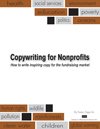The preferred answer to the question raised by the headline may not be as obvious as you think.
 Granted … your fundraising appeals are filled with actual events, facts and details. You write about the truth. You write about what’s happening to the people and places your mission serves.
Granted … your fundraising appeals are filled with actual events, facts and details. You write about the truth. You write about what’s happening to the people and places your mission serves.
Therefore it may seem as though the preferred answer is pure nonfiction.
However, the quality of your writing will be enhanced … the emotion you convey will be deeper … the response you trigger will be greater if you borrow tips from fiction writers.
That’s why I say the answer is a blend of the two.
Even if you don’t see it this way, you’re always telling your nonprofit’s story. Sometimes you bring in the people who benefit directly from your charity or association’s mission. And other times you write more generically. The fact remains that one way or another you are telling a story in each marketing message.
And that’s why your nonprofit copywriting will benefit from how fiction writers go about their craft.
I came across an article that covered this point nicely, “7 Things Content Marketers Can Learn From Fiction Writers,” by Pratik Dholakiya on ConvinceAndConvert.com.
Here are the seven tips you can borrow from fiction writers to strengthen your nonprofit copywriting:
1. The Art of Suspense
A good story has drama, suspense, mystery and unsolved problems – many unknowns. Suspense keeps your donor or member reading. It keeps them engaged.
There are specific building blocks to a memorable nonprofit story (follow the link to an earlier post I wrote on the subject). Our brains are wired to solve problems. So open with a problem (a challenge); then keep readers interested as you highlight on the struggle; and end with the resolution. Those are the basic parts of a good story. If there’s a surprise ending it’s even better.
2. If it sounds like writing, rewrite it
Write like you talk. Be conversational. Lose the jargon. Be warm and personable.
This also refers to the fact that writing short copy is harder than writing long copy. Much harder.
Part of the secret to compelling short copy – or any copy for that matter – is knowing what to delete and what to keep. Begin by sending most of the adverbs and adjectives to the trash can. Keep enough of the details to make the story clear. Think of it as a trim, physically fit person as opposed to a fat person. Trim the fat. Keep it lean and on point.
Also focus your writing on ACTIONS. What people are doing. This style of writing is more interesting and triggers your reader’s brain to respond. Read, “How science helps you write better fundraising stories”, for more on this topic.
3. Show … don’t tell
Don’t TELL us how wonderful your charity or association is. That’s egotistical and boring.
Instead, SHOW us that your organization is amazing. Use stories to put it into action. Give specifics and examples which can often be shared through a story. This includes sharing photos related to the story and perhaps a video. But again, write about actions to prove your point. Don’t pontificate with adverbs and adjectives.
4. Embrace conflict
There are advocacy groups embedded in controversy and conflict. Their mission may center on something that is at the heart of our core beliefs and values. Political nonprofits fall into this grouping.
But that’s not all that I’m talking about.
What problems does your organization solve? How does a donor make the world a better place by sending you money? How are you making life and/or work easier and more profitable for members of your association? What’s in it for THEM? What conflicts are you helping them resolve – either personally in the case of many associations; or indirectly for someone else in the case of many charities?
Drawing attention to conflict in your nonprofit copywriting makes it more engaging.
5. Every character should want something
Whatever you write about, think of it as a “character.” Then write about what the character wants.
The character might be a member of your association. Or a beneficiary of your charity’s mission. It might be your reader or even your organization.
Why think of it as a character? Because again, our brains are wired to be more interested and more responsive to what is “wanted” along with the obstacles the character must overcome in order to fill that want.
6. Write what you love . . .
I know you’re passionate about your cause. But that doesn’t mean you love every writing assignment you receive.
The scary thing is that your lack of passion or enthusiasm comes through in your writing whether you realize it or not. This means it’s less effective – fewer funds raised.
Here are tips on how to recharge your batteries and kindle the flame of passion in your writing.
7. Take from other writers
This does NOT mean plagiarism!
It simply means borrowing ideas from other organizations – including the for-profit world.
You’ve probably already done this. For example: What ideas did you bring home and test from the last nonprofit conference you attended? Or what appeal did you personally receive and then turn around and borrow from to craft your own direct mail letter or email?
Bottom line: Your nonprofit marketing and fundraising efforts will get higher response when it incorporates many of the characteristics of great fiction writing.
Hurricanes, Mysteries and Fundraising … what they have in common and how it helps you write stronger appeals
Storytelling for Nonprofits – Why it works
“Aspiration” inspires donors to respond … how “aspiration” benefits your nonprofit
